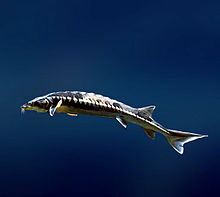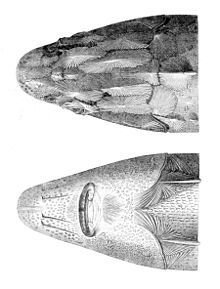Bastard sturgeon
| Ship sturgeon | |
|---|---|

| |
| Scientific classification | |
| Domain: | Eukaryota |
| Kingdom: | Animalia |
| Phylum: | Chordata |
| Class: | Actinopterygii |
| Order: | Acipenseriformes |
| Family: | Acipenseridae |
| Genus: | Acipenser |
| Species: | A. nudiventris
|
| Binomial name | |
| Acipenser nudiventris Lovetsky1828
| |
| Synonyms[3][4] | |
| |
Thebastard sturgeon,also known as thefringebarbel sturgeon,ship sturgeon,spiny sturgeon,orthorn sturgeon(Acipenser nudiventris),[5]is a species of fish in the familyAcipenseridae.[1]These fish are typically found along thebenthosof shallower waters near shorelines orestuaries.[5][6]
Feeding
[edit]Acipenser nudiventristypically feed on other animals near thebenthosincluding: insect larvae,mollusks,crustaceans,and other smaller fish.[5][7][8]
Reproduction
[edit]Acipenser nudiventrisare usuallyanadromous—meaning they live in saltwater and travel to freshwaters to deposit eggs—but some can spend their entire life cycle in freshwater.[8]Because they travel from saltwater to freshwater to spawn, they often live nearby estuaries.[8]Migration to freshwaters for deposition of eggs occurs during spring between the months of March and May, and fall between October and November.[8][6]On average, female bastard sturgeon produce between 200,000 and 300,000 eggs over the course of their lifetime.[7]The youngAcipenser nudiventriscan live in freshwater for years following birth prior to traveling to the sea, though many migrate to the sea soon after birth.[5]The average time between birth of subsequentAcipenser nudiventrisis around 15 years; variation in generation time of this species is somewhat dependent on human fishing patterns and whether the species is thriving in its environment.[8]
Conservation status
[edit]Formerly abundant in theBlack,AralandCaspian seas,its range is now primarily limited to theUral River(inRussiaandKazakhstan), with possiblerelictpopulations in theRioni RiverinGeorgiaand theSafid RudinIran.[8]One of the most established populations is one inLake BalkhashinKazakhstan,well outside its natural range, where they were introduced in the 1930s for commercial purposes.[5]A decline in the abundance ofAcipenser nudiventrishas been reported due to overfishing and damming, which have led to limitations placed on fishing for bastard sturgeon in areas such as the Ural River.[8][9]In order to alleviate concerns with rapidly decreasingAcipenser nudiventris,an effort was made to raise these fish in captivity before releasing them back into rivers they once inhabited.[7]

References
[edit]- ^abGesner, J.; Freyhof, J.; Kottelat, M. (2010)."Acipenser nudiventris".IUCN Red List of Threatened Species.2010:e.T225A13038215.doi:10.2305/IUCN.UK.2010-1.RLTS.T225A13038215.en.Retrieved17 November2021.
- ^"Appendices | CITES".cites.org.Retrieved14 January2022.
- ^Froese, R.; Pauly, D. (2017)."Acipenseridae".FishBaseversion (02/2017).Retrieved18 May2017.
- ^"Acipenseridae"(PDF).Deeplyfish- fishes of the world.Retrieved18 May2017.
- ^abcdeVecseia, Paul; Artyukhinb, Evgenii; Peterson, Douglas (2002)."Threatened fishes of the world: Acipenser nudiventris Lovetsky, 1828 (Acipenseridae)"(PDF).Environmental Biology of Fishes.65(4): 455–456.Bibcode:2002EnvBF..65..455V.doi:10.1023/A:1021124904613.S2CID26573687.
- ^abLovetzky (1828)."Fringebarbel sturgeon (Acipenser nudiventris)".Marine Species Identification Portal.Archivedfrom the original on 10 April 2021.Retrieved9 April2021.
- ^abcSivkov, Ianaki; Stefanov, Tihomir; Trichkova, Teodora (2011).Red data book of the republic of Bulgaria.Vassil Golemansky, Dimitar Peev, Valko Biserkov, Bŭlgarska akademii︠a︡ na naukite. Sofia: Bulgarian Academy of Sciences. p. 48.ISBN978-954-9746-21-1.OCLC995229803.
- ^abcdefg"Thorn Sturgeon (Acipenser nudiventris) Ecological Risk Screening Summary"(PDF).U.S. Fish and Wildlife Service.29 August 2018.Archived(PDF)from the original on 10 April 2021.Retrieved9 April2021.
- ^Abdolhay, Hossein (2004).Marine Ranching.Rome: FAO Fisheries Technical Paper. p. 170.ISBN92-5-104961-0.


